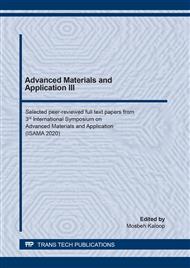p.1
p.6
p.12
p.18
p.23
p.29
p.34
p.41
p.47
Casting of Clad Strip Consisting of Al-Sn Alloy and Pure Aluminum
Abstract:
Casting of clad strip consisting of Al-40%Sn-1%Cu alloy and 1050 pure aluminum from molten metals was attempted using an unequal diameter twin-roll caster equipped with a scraper. The liquidus line and solidus line of the Al-40% Sn-1% Cu alloy are 620 °C and 220 °C, respectively. The liquidus line and solidus line of the 1050 are 657 °C and 646 °C, respectively. Therefore, solidification temperatures of the two aluminum alloys are much different. When an Al-40%Sn-1%Cu solidification layer was bonded to a solidification layer of the 1050 alloy, the temperature of the 1050 solidification layer surface was higher than the solidus line of Al-40% Sn-1% Cu. However, the Al-40% Sn-1% Cu alloy could be bonded to the 1050 strip and a two-layer clad strip could be cast. The interface between the two strips was very clear. Electron Probe Microanalysis (EPMA) indicated that Sn in the Al-40% Sn-1% Cu alloy did not diffuse into the 1050 alloy. Tensile shear tests were conducted using the as cast clad strip, and no breakage occurred at the interface between the strips but only in the Al-40% Sn-1% Cu layer. This result confirmed that the two strips were strongly bonded at the interface.
Info:
Periodical:
Pages:
23-28
Citation:
Online since:
August 2020
Authors:
Keywords:
Price:
Сopyright:
© 2020 Trans Tech Publications Ltd. All Rights Reserved
Share:
Citation:


